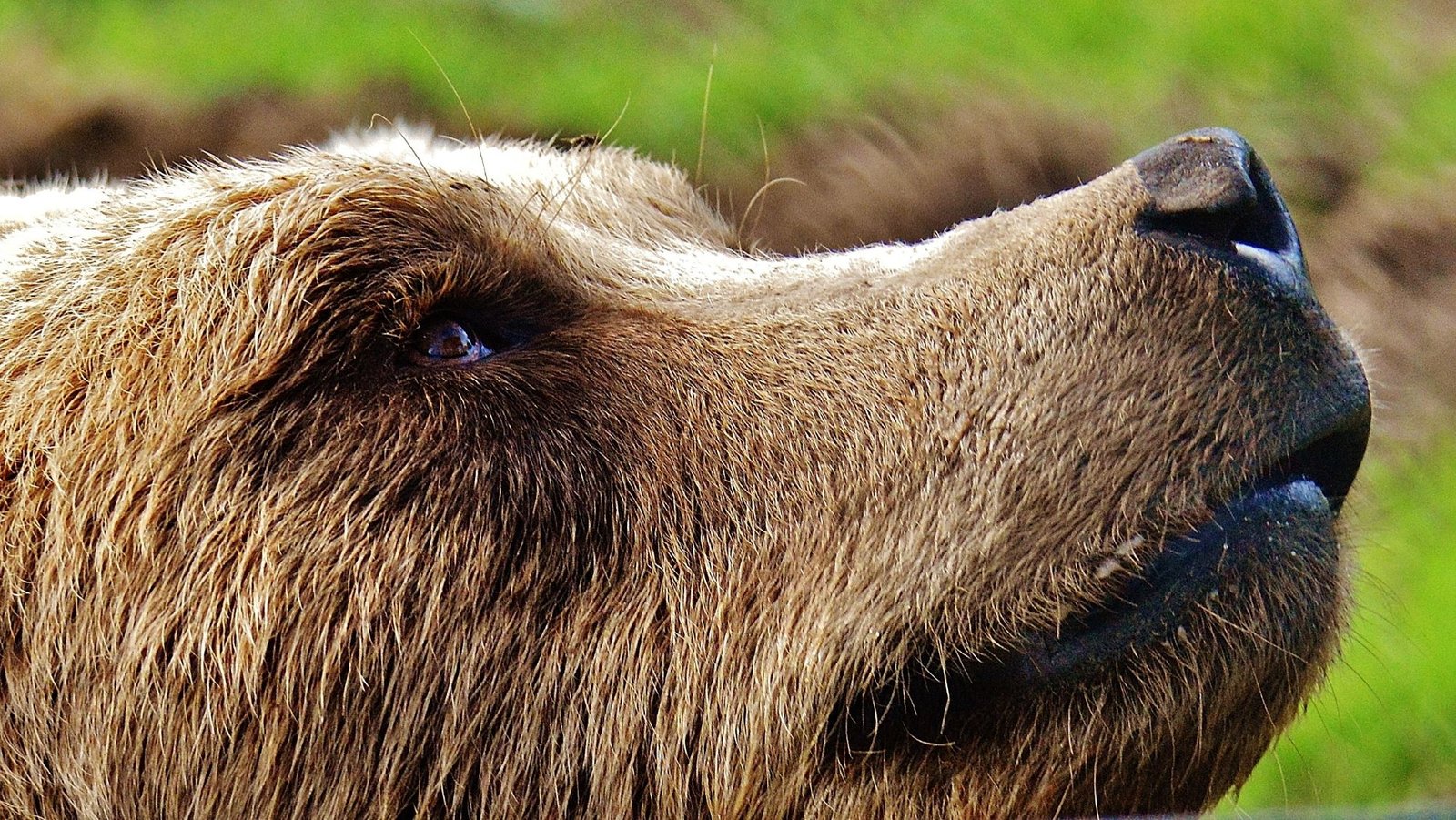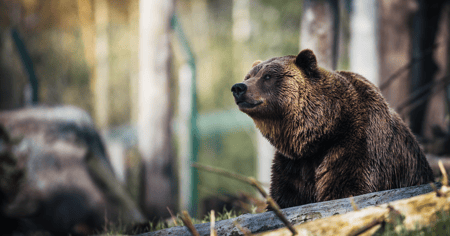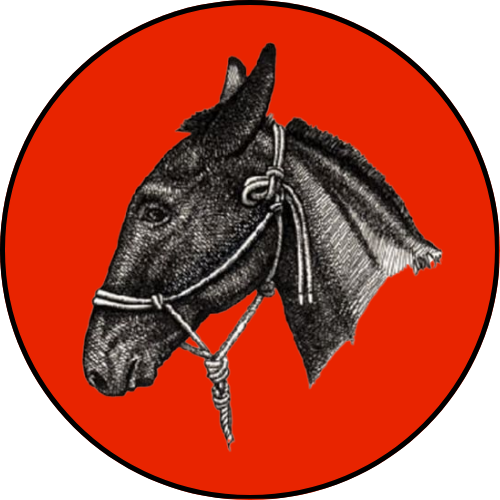Navigating Grizzly Territory: Understanding the Realities and Joys of Bear Country in Montana”
Dive into the world of grizzly bears with a seasoned wilderness guide, unraveling common fears, understanding bear behavior, and learning how to coexist safely in Montana’s stunning landscapes.

Grizzly Bears – Danger or Delight
Grizzlies, just the word can conjure up some strong emotions. If the only place you’ve ever seen a grizzly is on the internet, you’re bound to think their just vicious predators, spending every waking moment searching out innocent campers to eat. All those photos of snarling teeth and long claws can be disconcerting when you learn these animals frequent some of the best recreation areas that Montana has to offer. All this bad PR can lead to fear, and fear can be immobilizing.
Unraveling the fear
People’s fear of grizzly bears is often rooted in a combination of factors, including the bear’s size, strength, potential for aggression, and the perception of danger. While some level of caution around these powerful animals is justified, the extent of fear can vary based on individual experiences, cultural beliefs, and media portrayals.
Grizzly bears are one of the largest land predators, with adult males weighing up to 600-800 pounds or more. The idea of facing a large, powerful animal can evoke a primal fear response. While grizzlies are not inherently aggressive toward humans and often try to avoid interactions, their behavior can be unpredictable, especially in specific situations like surprising a bear or getting too close to a bear cub.
Media, including movies, documentaries, and news stories, often emphasize dramatic encounters or negative interactions between humans and grizzly bears. These portrayals can contribute to a skewed perception of the likelihood of dangerous encounters and can magnify people’s fears. Cultural stories, myths, and traditional beliefs have shaped perceptions of bears in various societies. In some cultures, bears are seen as symbols of power, while in others, they are associated with danger or revered as spiritual beings. These cultural factors can influence how people approach and respond to encounters with grizzly bears.
I believe one of the largest contributors to people’s fear of grizzly bears is just human’s tendency to fear anything unknown. For many people, encounters with wildlife, especially large predators like grizzly bears, are rare. Lack of familiarity and understanding about bear behavior, proper precautions, and safety measures can contribute to fear and anxiety. The overall lack of being in wild environments can also affect a person’s comfort level.
While fear of grizzly bears is based on real factors, it’s important to note that these fears can sometimes be exaggerated or misinformed. Grizzly bears, like any wild animals, are not inherently out to attack humans. They primarily want to avoid confrontations and seek food, shelter, and safety.
They’re just trying to make a living
Most of the time, grizzlies are busy with the day-to-day business of just surviving. Grizzly bears are omnivores, consuming a wide range of foods including vegetation, insects, small mammals, and carrion. If you think about the amount of food it takes for an average 200-pound human to survive, it’s approximately 2500 – 3500 calories per day. A grizzly can weigh up to 4 times the amount of a human, that equals a lot of needed calories. During hyperphagia prior to denning they can consume up to 20,000 calories a day. Now imagine that those calories had to come from some berries or insects you could scratch out from under a rock or log, or maybe, if you were really lucky, from some carrion you were fortunate enough to come across. You could hunt for a larger source of concentrated protein and fat, but it would have to balance out with the amount of energy it takes to pursue it.
Now, what if the number of days you could eat in a year were cut almost in half? The average grizzly can spend up to six months every year denning in a state of torpor. Torpor is a state of reduced activity and metabolic rate that animals can enter for shorter periods. Unlike hibernation, animals in torpor can be more easily awakened and can quickly return to their active state. Torpor helps animals conserve energy during times of unfavorable conditions, such as cold weather or food scarcity.
Even though insects like ants and moth larvae are little lipid bombs, it seems like getting enough calories to build your fat bank account against future withdrawals would be a rough go. It’s not surprising that a bear could get a serious case of the “hangries”. What most often motivates a bear to interact with humans is its stomach! Other than the occasional surprise bumping into each other on the same trail, most encounters involve their insatiable need for calories. Human’s calorie dense food along with other attractants mean you’ve got a bear’s attention. Easy calories can distract a bear from its natural aversion to humans. Accidentally interrupting a meal they’ve already lucked upon is also a reason bears would confront people. They are just trying to hold on to their dinner. Human activities like concentrating tasty domestic animals like herds of sheep or a yard of beehives can also seem like an easy payday to a hungry bear.

Getting Acquainted with Your Furry Neighbor
Grizzly bears in Montana inhabit a variety of ecosystems, from high alpine regions to lower elevation forests and riparian zones. Primarily they’re found in the northwestern part of Montana, particularly in and around Glacier National Park, the Bob Marshall Wilderness Complex, and the Greater Yellowstone Ecosystem. They rely on a mix of habitats for different activities such as foraging, denning, and breeding. Key habitat features include food sources like berries, nuts, roots, and carrion, as well as access to water sources, adequate shelter, and suitable denning sites.
Another reason people and bears can come in contact is we’re hanging out in their space. The same places that make good bear habitat also make great places to hunt, fish, and camp. You should travel in their neighborhood with enough situational awareness to know if they’re home, or if you’ve dropped by their house unannounced and they’re having dinner. Know what signs a bear leaves and what it could mean. Rolled rocks and busted dead logs often are a sign that bears are searching for insects. Divots in shale ridges or roots scooped out of dirt banks can show where claws dug. Bears will also scratch against trees leaving scent, hair, or claw marks to let other bears know this territory is taken. Large piles of scat with berry seeds, hair, or fish bones let you know bears have been feeding in the area. If you see or hear a large presence of scavenger birds, be cautious as there could be a gut pile or carrion nearby. If you see bear cubs, be extra vigilant as their momma isn’t far away. You don’t want to get between them.
Time of year and time of day make a difference of when you might run in to Mr. Bruno. Mornings and twilight most wild animals are more active. Bears often are more nocturnal, especially when humans are in the woods in the daylight hours. In the Spring they wake up needing food and will often be in riparian corridors that sprout the first green shoots. Most of the time they live a solitary life or in a small family group of moms with cubs. But in early summer, they begin their mating season and may be found in more condensed groups competing for a date. In fall their concentration is back on the gravy train, and any promise of a good meal is all they can think about. In winter they den, although there’s no set time for bed, they usually start denning anywhere from October to December.
Above all when learning about grizzlies, know they deserve our respect. They are an apex predator. They are intelligent. They are strong. They’re protective of their families. They are much faster than us. They can run at speeds up to thirty-five miles an hour. They often use man-made trails for it’s easier travel. Because of their acute sense of smell, they can smell a potential meal three miles away or more. They are easily conditioned and seem to be able to tell what day the garbage is set out. After only one encounter with a bird feeder at the neighbor’s cabin, they will look for bird feeders at every cabin. Know that they can learn to associate a delicious steaming pile of elk guts with hunter behavior. If your rifle shot rings out across the valley, you may have just rung the dinner bell.

Are grizzly bears dangerous to humans?
Yes, they can be dangerous. Should that keep us out of the woods? Not if you educate yourself and do your part to minimize the chance for conflict. The same could be said for another large dangerous animal in the woods, the horse. Horses have injured and even killed many more people annually than grizzly bears ever have, but they are still willingly used every year in the backcountry. Horses can cause you injury without even trying, just because of their size. Likewise, a grizzly could give you an annoyed swat in a surprise encounter and you could be seriously harmed. Just as a person’s knowledge and skills with horses can make an easy pack trip to hunting camp possible, knowing how to make your way in bear country can lead to some of the most amazing adventures in Montana. Conflicts can be more likely in situations involving a food source or protecting their young, but they are not just out looking for a fight.
How can I keep myself safe?
The first and most important solution is to avoid confrontation by properly storing food and garbage. It’s better for you and better for the bear if they don’t get conditioned to human food. A fed bear equals a dead bear. Store all attractants, both human and livestock food, garbage, or waste from fish or game animals in bear proof containers, if possible. Hang attractants in trees so the object is four feet out from the trunk and ten feet from the ground. Have a separate area for cooking and storing food 100 yards away from where you sleep. Bear-appropriate electric fences around attractant or camp areas can reduce the need to hang items where trees may be limited.
Don’t underestimate the ability of sound to keep bears at bay. The sound of a bell on your pack or a loud human voice can let bears know you’re around and keep surprises at a minimum. Loud noises like banging on pots and pans or horn sirens can discourage a bear from coming into camp. Loud noises can be effective, but sometimes impractical when hunting. Even when hunting in the field, if a bear crosses my trail, I will still stand up with my bear spray out and ready and give a good stern shout of “You Git” while aiming at the bear. Maybe it’s just the abrupt sound or the self-assured posture, I’m not sure, but it has been effective for me in every encounter so far. And after many years and numerous bears, I’ve had yet to even deploy my bear spray. The sound helps but having bear spray ready is the ticket!

Carry Bear Spray
Carry bear spray and know how to use it. Keep it immediately at hand, especially in areas where bear sign is evident. Practice removing the safety clip and spraying with an inert container so you can do it quickly if needed. A bear can cover 30 yards distance within a few seconds. Make sure to aim the spray at the level a bear’s face, holding the can with two hands helps keep the nozzle from pointing too high. Spraying in a “Z” patterned curtain for the bear to run into also helps get the spray where it does the best. If you’ve ever personally experienced even a minute amount of the active bear spray compound, with a bear’s acute sense of smell being 2100 times more sensitive than ours, it would give you confidence in its power. In several studies of human-bear encounters, the capsaicin in that can will stop a charging bear most effectively, with the least damage to you or the grizzly, 98% of the time.
What about guns? I hear a lot of comments from people that have firearms that they would rather just shoot a charging bear, even if it wasn’t against the law. My answer to that is that to my knowledge there are very, very few people with the skills required to effectively make that shot. The vital area on a charging bear is the equivalent target size of a basketball being shot towards you at 30 miles per hour, only growling and with teeth. Firearm caliber and shooter’s ability notwithstanding, the needed timing makes the required accuracy almost impossible. And even if you make the shot, a shot bear can still live long enough to harm or kill you 50% of the time.

Special considerations for game retrieval
What if you have a successful hunt? If field dressing a game animal, it helps to have another person to keep watch of your surroundings. If you’re on your own, take several moments to survey your surroundings repeatedly while field dressing. Be alert and keep a cool head. Be extra mindful of loaded firearms. Hunters have even shot their own hunting partners from nerves in the heat of the moment. The pile of guts is the most attractive portion and needs to be separated from the carcass. Use a space blanket, a tarp, or even sticks to drag the gut pile as far away from the meat as possible, 100 yards is ideal. Try to place the guts in an area that is observable when leaving and entering the area. Even if a bear comes by to investigate, it will most likely wait until you leave to enter the kill site, and the guts will be the first stop. Most of the time an elk carcass must be quartered and takes several trips to transport it. If you must leave it hang it, 4 feet out and 10 feet up. If you’re unable to hang the meat you can’t carry, sometimes items with human sent left near the carcass let them know you claim it and will deter a bear. Change out your socks and leave your sweaty socks by the carcass or urinate around the perimeter. If you need to leave and come back to pack out the meat, you should be able to see if a bear has been on the gut pile. If a bear claims your carcass, let them have it. Cautiously leave the area and report it to the local game warden.
A Part of Healthy Habitat
The truth is we’re lucky to have a habitat that can support this amazing keystone species. Grizzly bears have a disproportionately large impact on their environment relative to their abundance. The presence or absence of a keystone species can significantly influence the structure and function of an ecosystem.
Grizzly bears play a crucial role in shaping and maintaining the health and diversity of their habitats through various ecological interactions, include seed dispersal, ecosystem engineering, carrion consumption, regulation of prey populations, influence on insect populations, scavenging, and competition with other predators, such as wolves and coyotes.
Ecosystems that contain an adequate number of apex predators, predators at the top of the food chain, have much healthier ungulate populations with less diseases like Chronic Wasting Disease and Epizootic Hemorrhagic Disease. If you’re a big game hunter that enjoys healthy populations of deer and elk, grizzly bears are one of the species on your side.
Overall, the activities of grizzly bears have far-reaching effects on the structure, diversity, and dynamics of western ecosystems. Their behaviors contribute to the health of plant communities, impact other species’ distribution and behavior, and help maintain the overall balance of these ecosystems. As a keystone species, grizzly bears exemplify the interconnectedness of species within their habitats and highlight the importance of their conservation for the well-being of entire ecosystems.
My personal experience working and living alongside grizzly bears…
I personally find a landscape that includes grizzlies delightful. I’ve watched a mother grizzly patiently teach her cubs to look for bugs in old logs while they frolicked and climbed over her lowered head. I’ve been convinced that the huge boar with rippling golden fur, grazing along the hillside in the coming sunlight is right where he’s supposed to be. I’m the visitor, I’m the lucky observer. Even when I’ve been a dozen short yards from a sow with cubs coming up the trail or just stepped over a very large, fresh pile of scat on the way to field dress an elk, fear is never my natural reaction. When I’m guiding, I’m sure to take a good look at my surroundings. I’m cautious, I try to be prepared, but my first gut reaction when I see a bear is always amazement. The grizzly is truly an awe-inspiring creature.
Most of my time spent in the backcountry I’m guiding elk and deer hunters. If you want to immerse yourself in a wild elk’s habitat without it knowing, you’re going to see other wild animals, too. If I see a grizzly, I know that I’m doing my job right. Anytime I can see a wild animal going about its daily business, I’ve successfully become part of their wild world.
Ultimately, while a certain level of caution and respect for grizzly bears is wise, fostering an understanding of their behavior and learning how to coexist safely in bear habitats can help mitigate unwarranted fears, promote responsible wildlife management, and allow you to enjoy recreating in Montana’s landscape.
Babette Eustance
MT Licensed Guide #10585

